
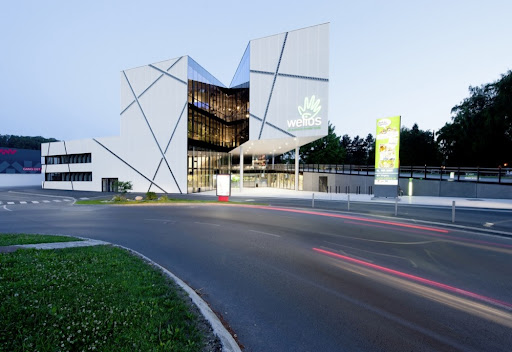


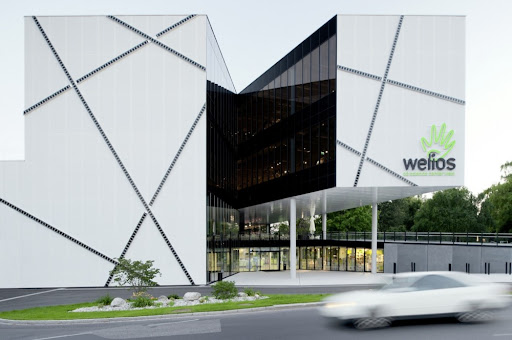
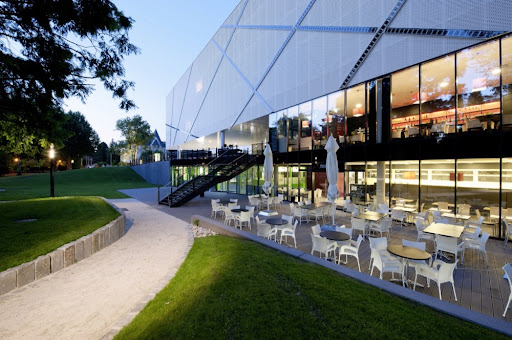
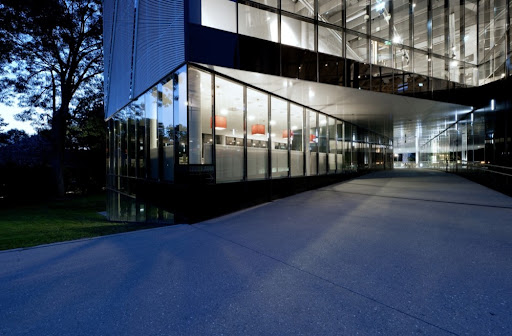
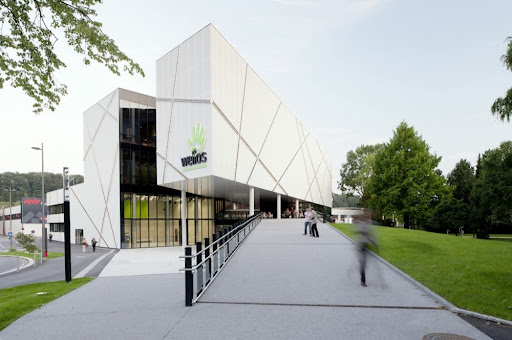
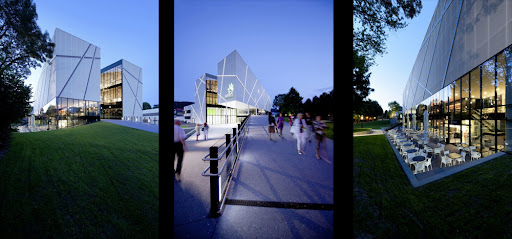
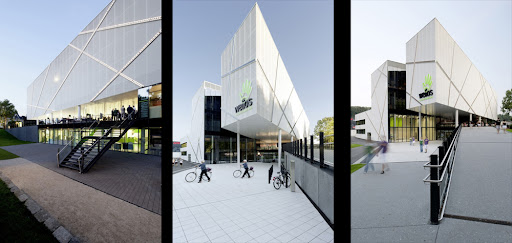
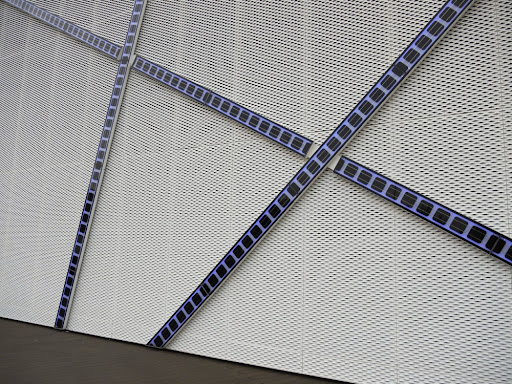
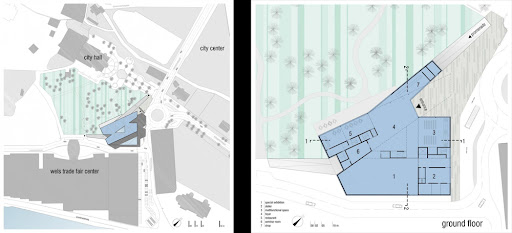
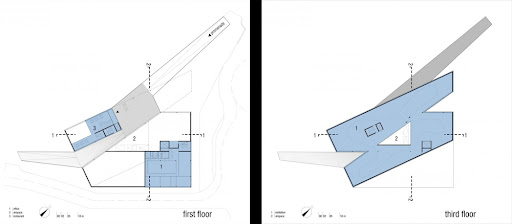
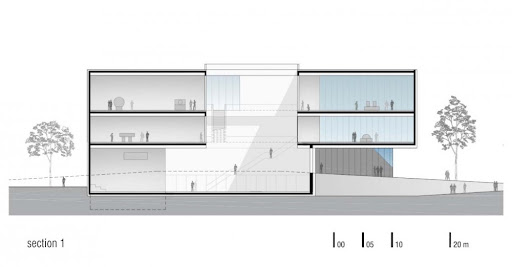
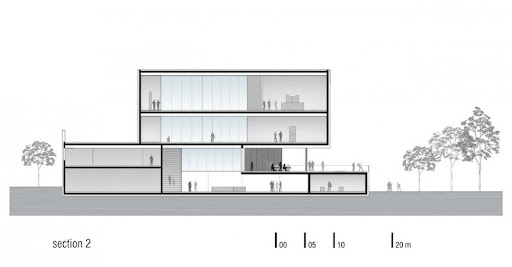
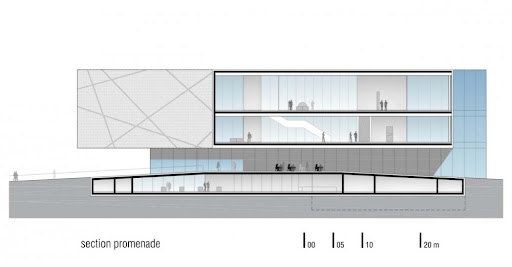 Architect: Archinauten Dworschak + Mühlbachler ZT Gmbh Location: Weliosplatz 1, 4600 Wels, Austria Client: OÖ Science-Center Wels Errichtungs-GmbH. Operating Company: OÖ Science-Center Wels Betreibs-GmbH. „Welios“® Project Management: Archinauten Dworschak + Mühlbachler ZT Gmbh Photographs: Dietmar Tolerian A bundle of energy – the „Welios“® I OÖ Science-Center Wels with the theme of “renewable energy” highlights the efforts of the city of wels to position itself as a city of energy. Welios® is a science museum that makes it possible to experience physical phenomena in interactive arrangements. architecturally it is also an experimental landscape, an open and dynamic spatial conception of ramps, sloping walls and flowing lines. The science center presents itself as a spectacular large sculpture, a monument and landmark that gives the location at the periphery of the historical city center the urbanist quality it otherwise lacks. the science center is the urban hub in the transitional area between the city center and the fair grounds / amusement park. The construction is characterized by the guiding idea of “energy”, which gives the building its form. A massive body with a hard shell is opened up and shaped by the energy inside it. The resultant recesses allow glimpses into the interior of the museum and serve to light the thematic spaces. Concept: bundle of energy The science center with the theme “renewable energy” highlights the efforts of the city of wels to position itself as a city of energy. these kinds of strategies and political programs enhance the branding of the city in global competition. The science center is a science museum that makes it possible to experience physical phenomena in interactive arrangements. Architecturally it is also an experimental landscape, an open and dynamic spatial conception of ramps, sloping walls and flowing lines. The science center presents itself as a spectacular large sculpture, a monument and landmark that gives the location at the periphery of the historical city center the urbanist quality it otherwise lacks. The science center is the urban hub in the transitional area between the city center and the fair grounds / amusement park. the construction is characterized by the guiding idea of “energy”, which gives the building its form. A massive body with a hard shell is opened up and shaped by the energy inside it. The resultant recesses allow glimpses into the interior of the museum and serve to light the thematic spaces. The outside spaces between the city and the building are conceived as a continuum, developed from the overlapping of movement directions and gaze axes. a central, public footpath axis leads across the science center from the city to the fair grounds. The restaurant with a view of the public garden is located along this footpath. the entrance ramp forms a clear separation between the park landscape and the space of the street, defining the funnel-shaped forecourt with the main entrance. Visitors enter the building under the extensively projecting roof and reach the central entrance hall. low at first, but then immediately opening up the gaze: visitors look up into unsuspected heights, which encourages them to quickly climb the cascading steps up to the exhibition spaces. The interior atrium reaches up to below the roof and is illuminated from above. The foyer fulfills functional requirements and can be used together with the multi-function room and the rooms of the special exhibition in variable combinations for events. Restaurant and shop are located on the ground floor in separate sections of the building, but as spatial sequences of the foyer. Both areas are closely integrated into museum operations, but also function independently from them. the gastronomy section on two levels with restaurant and cafe/bar is accessible both from the public promenade and from the outdoor cafe in the public garden. If needed, the outdoor cafe can be extended into the exterior area of the science center. The x-shaped configuration of the exhibition rooms allows for a flexible arrangement of the thematic spaces – sometimes the view to the outside is closed, then the open atrium connects the rooms with one another. Other rooms allow a view to the outside, sunlight falls into the room. In this way sequences of spaces can be arranged with various sizes and characteristics in keeping with the exhibition concepts. The exhibition surfaces in the outside area are accessible from the foyer. shielded from the public traffic space by the footpath ramp, the outside area opens up to the public garden and the fairgrounds. The exhibition surfaces are close to nature, conceived as an integral part of the park landscape, without a spatial demarcation. uncontrolled access is hindered by a flat water moat, possibly in conjunction with an exhibit on the theme of “water”. For transportation access, the science center can be reached from the roundabout rosenauerstrasse. there is a bus access road with stops for brief drop-offs in front of the building by the street rosenauerstrasse. the central delivery area is also located there. The building is a solid construction as a cement body. the interior – ceilings, walls – is made in dry construction. The compact construction form and the highly insulated outside wall construction promise a high degree of energy efficiency. A shimmering white, expanded metal facade covers the entire body of the building as a homogeneous casing. glass walls are limited to the “opened up” recesses. Window openings in the external facade are blurred behind the metal curtain, which serves as a shading element at the same time. The line pattern is made with steel bands – the “force lines” on the facade. The back-lighting of these bands with energy-saving led light strips enables a variable design of the facade, ranging from a slight shimmer to dynamic effects. In this way, the science center is also imbued with the necessary presence in the dark and with an unmistakeable appearance.
Architect: Archinauten Dworschak + Mühlbachler ZT Gmbh Location: Weliosplatz 1, 4600 Wels, Austria Client: OÖ Science-Center Wels Errichtungs-GmbH. Operating Company: OÖ Science-Center Wels Betreibs-GmbH. „Welios“® Project Management: Archinauten Dworschak + Mühlbachler ZT Gmbh Photographs: Dietmar Tolerian A bundle of energy – the „Welios“® I OÖ Science-Center Wels with the theme of “renewable energy” highlights the efforts of the city of wels to position itself as a city of energy. Welios® is a science museum that makes it possible to experience physical phenomena in interactive arrangements. architecturally it is also an experimental landscape, an open and dynamic spatial conception of ramps, sloping walls and flowing lines. The science center presents itself as a spectacular large sculpture, a monument and landmark that gives the location at the periphery of the historical city center the urbanist quality it otherwise lacks. the science center is the urban hub in the transitional area between the city center and the fair grounds / amusement park. The construction is characterized by the guiding idea of “energy”, which gives the building its form. A massive body with a hard shell is opened up and shaped by the energy inside it. The resultant recesses allow glimpses into the interior of the museum and serve to light the thematic spaces. Concept: bundle of energy The science center with the theme “renewable energy” highlights the efforts of the city of wels to position itself as a city of energy. these kinds of strategies and political programs enhance the branding of the city in global competition. The science center is a science museum that makes it possible to experience physical phenomena in interactive arrangements. Architecturally it is also an experimental landscape, an open and dynamic spatial conception of ramps, sloping walls and flowing lines. The science center presents itself as a spectacular large sculpture, a monument and landmark that gives the location at the periphery of the historical city center the urbanist quality it otherwise lacks. The science center is the urban hub in the transitional area between the city center and the fair grounds / amusement park. the construction is characterized by the guiding idea of “energy”, which gives the building its form. A massive body with a hard shell is opened up and shaped by the energy inside it. The resultant recesses allow glimpses into the interior of the museum and serve to light the thematic spaces. The outside spaces between the city and the building are conceived as a continuum, developed from the overlapping of movement directions and gaze axes. a central, public footpath axis leads across the science center from the city to the fair grounds. The restaurant with a view of the public garden is located along this footpath. the entrance ramp forms a clear separation between the park landscape and the space of the street, defining the funnel-shaped forecourt with the main entrance. Visitors enter the building under the extensively projecting roof and reach the central entrance hall. low at first, but then immediately opening up the gaze: visitors look up into unsuspected heights, which encourages them to quickly climb the cascading steps up to the exhibition spaces. The interior atrium reaches up to below the roof and is illuminated from above. The foyer fulfills functional requirements and can be used together with the multi-function room and the rooms of the special exhibition in variable combinations for events. Restaurant and shop are located on the ground floor in separate sections of the building, but as spatial sequences of the foyer. Both areas are closely integrated into museum operations, but also function independently from them. the gastronomy section on two levels with restaurant and cafe/bar is accessible both from the public promenade and from the outdoor cafe in the public garden. If needed, the outdoor cafe can be extended into the exterior area of the science center. The x-shaped configuration of the exhibition rooms allows for a flexible arrangement of the thematic spaces – sometimes the view to the outside is closed, then the open atrium connects the rooms with one another. Other rooms allow a view to the outside, sunlight falls into the room. In this way sequences of spaces can be arranged with various sizes and characteristics in keeping with the exhibition concepts. The exhibition surfaces in the outside area are accessible from the foyer. shielded from the public traffic space by the footpath ramp, the outside area opens up to the public garden and the fairgrounds. The exhibition surfaces are close to nature, conceived as an integral part of the park landscape, without a spatial demarcation. uncontrolled access is hindered by a flat water moat, possibly in conjunction with an exhibit on the theme of “water”. For transportation access, the science center can be reached from the roundabout rosenauerstrasse. there is a bus access road with stops for brief drop-offs in front of the building by the street rosenauerstrasse. the central delivery area is also located there. The building is a solid construction as a cement body. the interior – ceilings, walls – is made in dry construction. The compact construction form and the highly insulated outside wall construction promise a high degree of energy efficiency. A shimmering white, expanded metal facade covers the entire body of the building as a homogeneous casing. glass walls are limited to the “opened up” recesses. Window openings in the external facade are blurred behind the metal curtain, which serves as a shading element at the same time. The line pattern is made with steel bands – the “force lines” on the facade. The back-lighting of these bands with energy-saving led light strips enables a variable design of the facade, ranging from a slight shimmer to dynamic effects. In this way, the science center is also imbued with the necessary presence in the dark and with an unmistakeable appearance.
Structural Engineer: Dipl.Ing. Helmut Schiebel Ziviltechniker Ges.m.b.H., A-4040 Linz Building Physics: TAS Bauphysik GmbH, A-4060 Leonding Electrical Planning: Hross & Partner Ges.m.b.H., 4050 Traun Building Equipment: Engelmann Consulting Energiesysteme GmbH, A-4382 Sarmingstein Construction Company: Bauunternehmung Rudolf Gerstl KG Façade Expanded Metal: Rudolf Schmidhofer GmbH Façade Glass: Kreuzroither Metallbau GmbH Façade System Supplier: Hydro Building Systemns GmbH Elevators: Kone AG Outside Space: Strabag AG Electric Installation: Elektrizitätswerk Wels AG
Source: Archinauten Dworschak + Mühlbachler ZT Gmbh milimetdesign – Where the convergence of unique creatives































